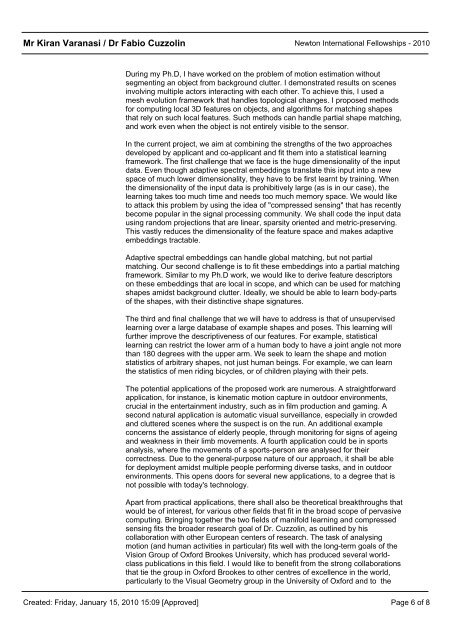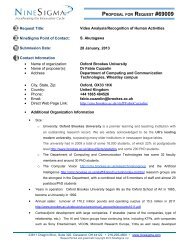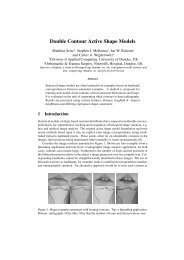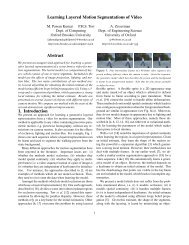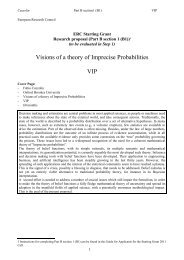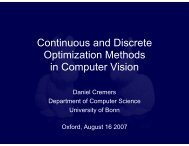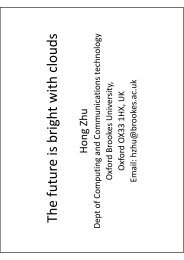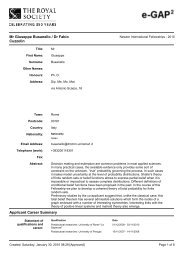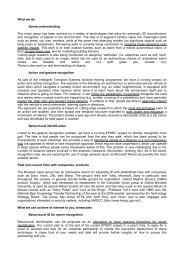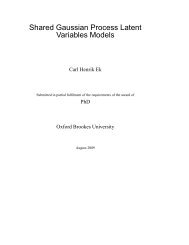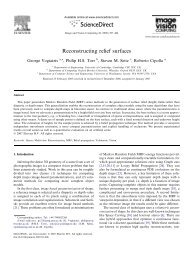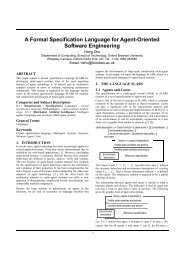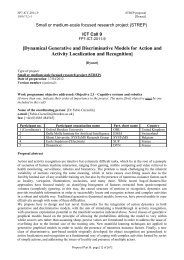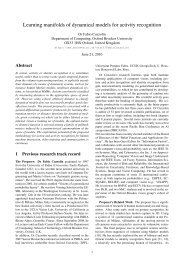Mr Kiran Varanasi / Dr Fabio Cuzzolin Applicant Career Summary
Mr Kiran Varanasi / Dr Fabio Cuzzolin Applicant Career Summary
Mr Kiran Varanasi / Dr Fabio Cuzzolin Applicant Career Summary
You also want an ePaper? Increase the reach of your titles
YUMPU automatically turns print PDFs into web optimized ePapers that Google loves.
<strong>Mr</strong> <strong>Kiran</strong> <strong>Varanasi</strong> / <strong>Dr</strong> <strong>Fabio</strong> <strong>Cuzzolin</strong> Newton International Fellowships - 2010<br />
Created: Friday, January 15, 2010 15:09 [Approved]<br />
During my Ph.D, I have worked on the problem of motion estimation without<br />
segmenting an object from background clutter. I demonstrated results on scenes<br />
involving multiple actors interacting with each other. To achieve this, I used a<br />
mesh evolution framework that handles topological changes. I proposed methods<br />
for computing local 3D features on objects, and algorithms for matching shapes<br />
that rely on such local features. Such methods can handle partial shape matching,<br />
and work even when the object is not entirely visible to the sensor.<br />
In the current project, we aim at combining the strengths of the two approaches<br />
developed by applicant and co-applicant and fit them into a statistical learning<br />
framework. The first challenge that we face is the huge dimensionality of the input<br />
data. Even though adaptive spectral embeddings translate this input into a new<br />
space of much lower dimensionality, they have to be first learnt by training. When<br />
the dimensionality of the input data is prohibitively large (as is in our case), the<br />
learning takes too much time and needs too much memory space. We would like<br />
to attack this problem by using the idea of "compressed sensing" that has recently<br />
become popular in the signal processing community. We shall code the input data<br />
using random projections that are linear, sparsity oriented and metric-preserving.<br />
This vastly reduces the dimensionality of the feature space and makes adaptive<br />
embeddings tractable.<br />
Adaptive spectral embeddings can handle global matching, but not partial<br />
matching. Our second challenge is to fit these embeddings into a partial matching<br />
framework. Similar to my Ph.D work, we would like to derive feature descriptors<br />
on these embeddings that are local in scope, and which can be used for matching<br />
shapes amidst background clutter. Ideally, we should be able to learn body-parts<br />
of the shapes, with their distinctive shape signatures.<br />
The third and final challenge that we will have to address is that of unsupervised<br />
learning over a large database of example shapes and poses. This learning will<br />
further improve the descriptiveness of our features. For example, statistical<br />
learning can restrict the lower arm of a human body to have a joint angle not more<br />
than 180 degrees with the upper arm. We seek to learn the shape and motion<br />
statistics of arbitrary shapes, not just human beings. For example, we can learn<br />
the statistics of men riding bicycles, or of children playing with their pets.<br />
The potential applications of the proposed work are numerous. A straightforward<br />
application, for instance, is kinematic motion capture in outdoor environments,<br />
crucial in the entertainment industry, such as in film production and gaming. A<br />
second natural application is automatic visual surveillance, especially in crowded<br />
and cluttered scenes where the suspect is on the run. An additional example<br />
concerns the assistance of elderly people, through monitoring for signs of ageing<br />
and weakness in their limb movements. A fourth application could be in sports<br />
analysis, where the movements of a sports-person are analysed for their<br />
correctness. Due to the general-purpose nature of our approach, it shall be able<br />
for deployment amidst multiple people performing diverse tasks, and in outdoor<br />
environments. This opens doors for several new applications, to a degree that is<br />
not possible with today's technology.<br />
Apart from practical applications, there shall also be theoretical breakthroughs that<br />
would be of interest, for various other fields that fit in the broad scope of pervasive<br />
computing. Bringing together the two fields of manifold learning and compressed<br />
sensing fits the broader research goal of <strong>Dr</strong>. <strong>Cuzzolin</strong>, as outlined by his<br />
collaboration with other European centers of research. The task of analysing<br />
motion (and human activities in particular) fits well with the long-term goals of the<br />
Vision Group of Oxford Brookes University, which has produced several worldclass<br />
publications in this field. I would like to benefit from the strong collaborations<br />
that tie the group in Oxford Brookes to other centres of excellence in the world,<br />
particularly to the Visual Geometry group in the University of Oxford and to the<br />
Page 6 of 8


